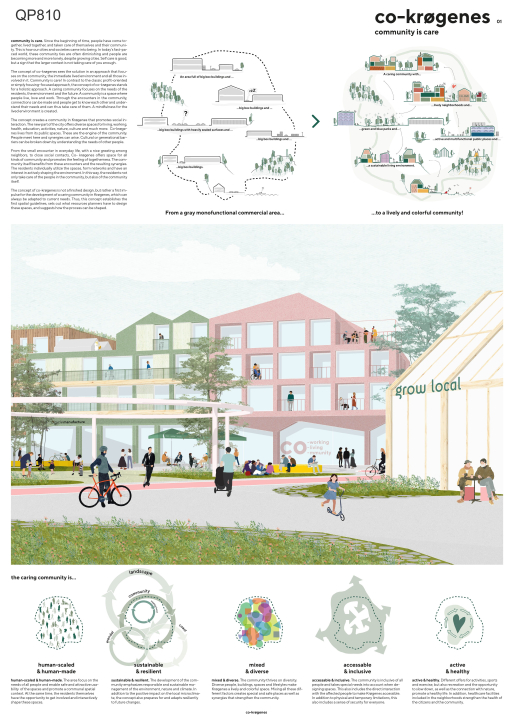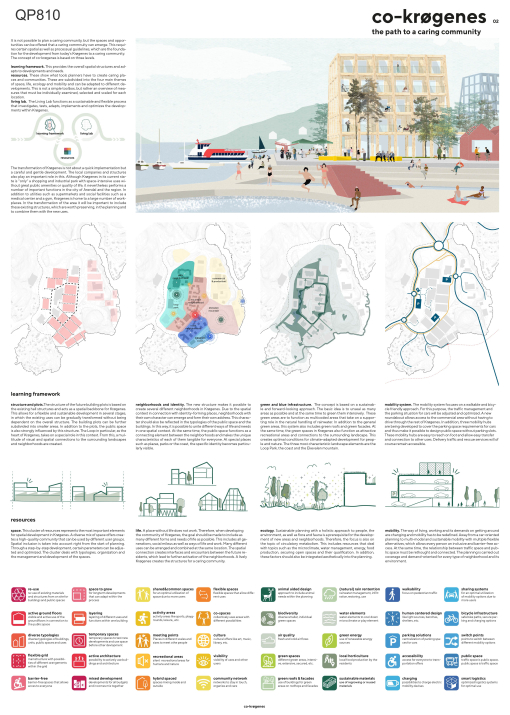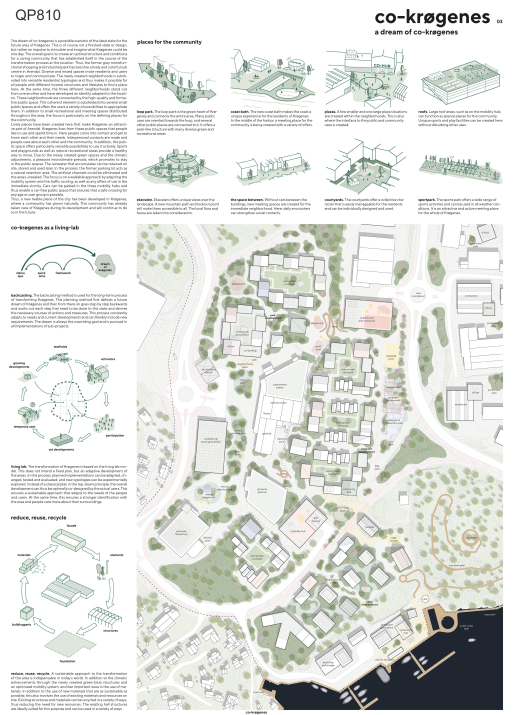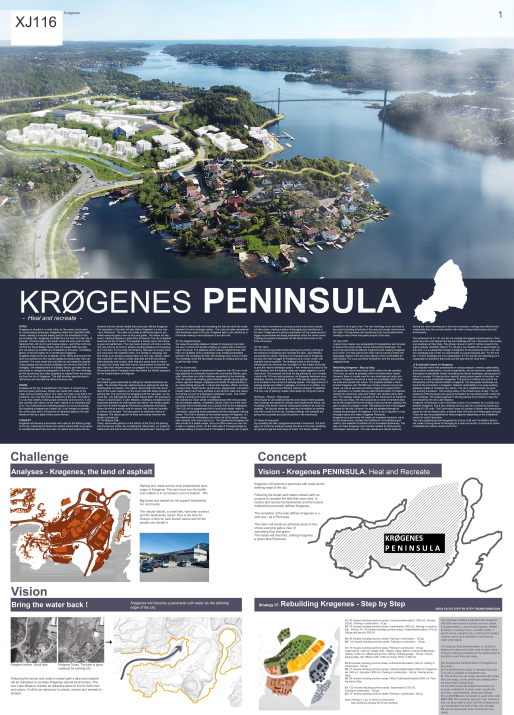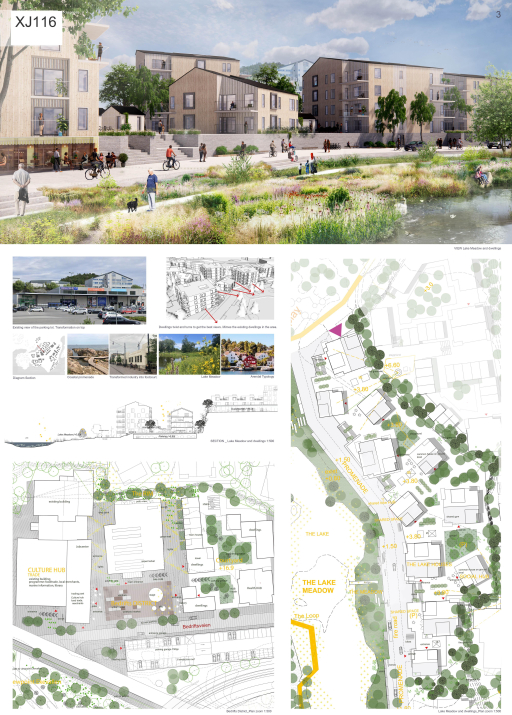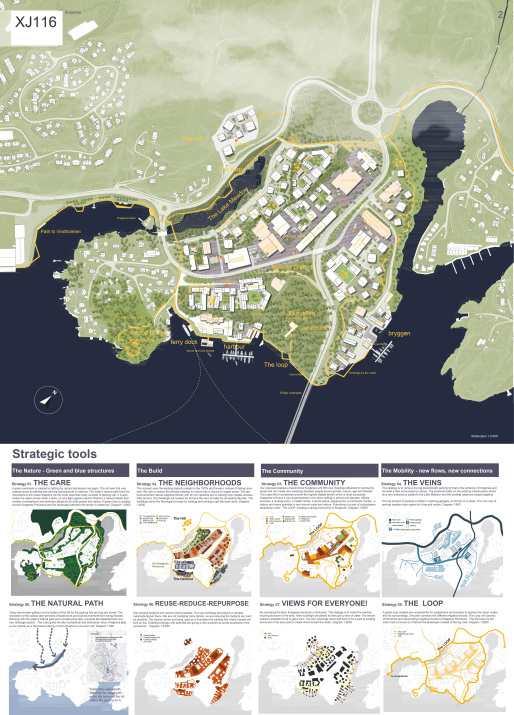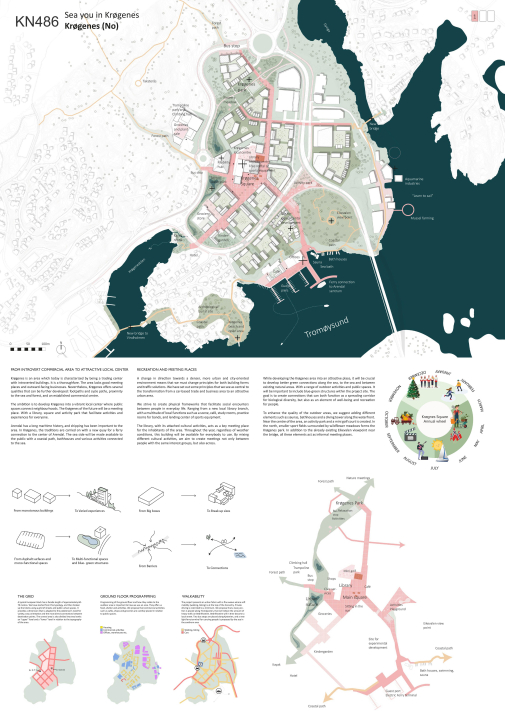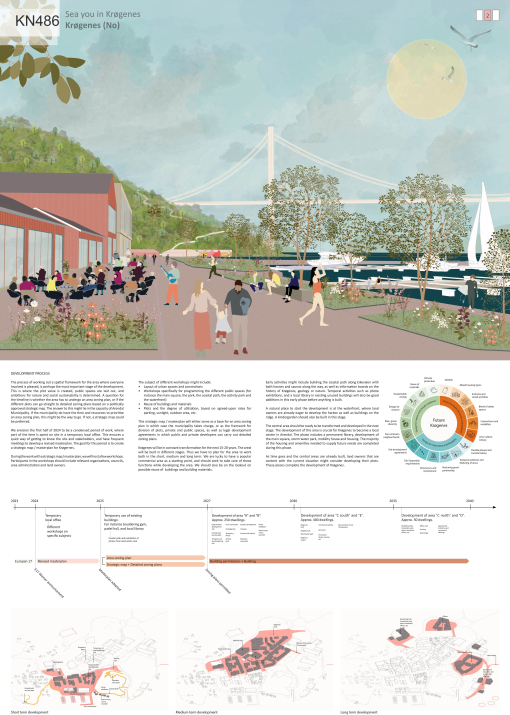The results for Krøgenes are here
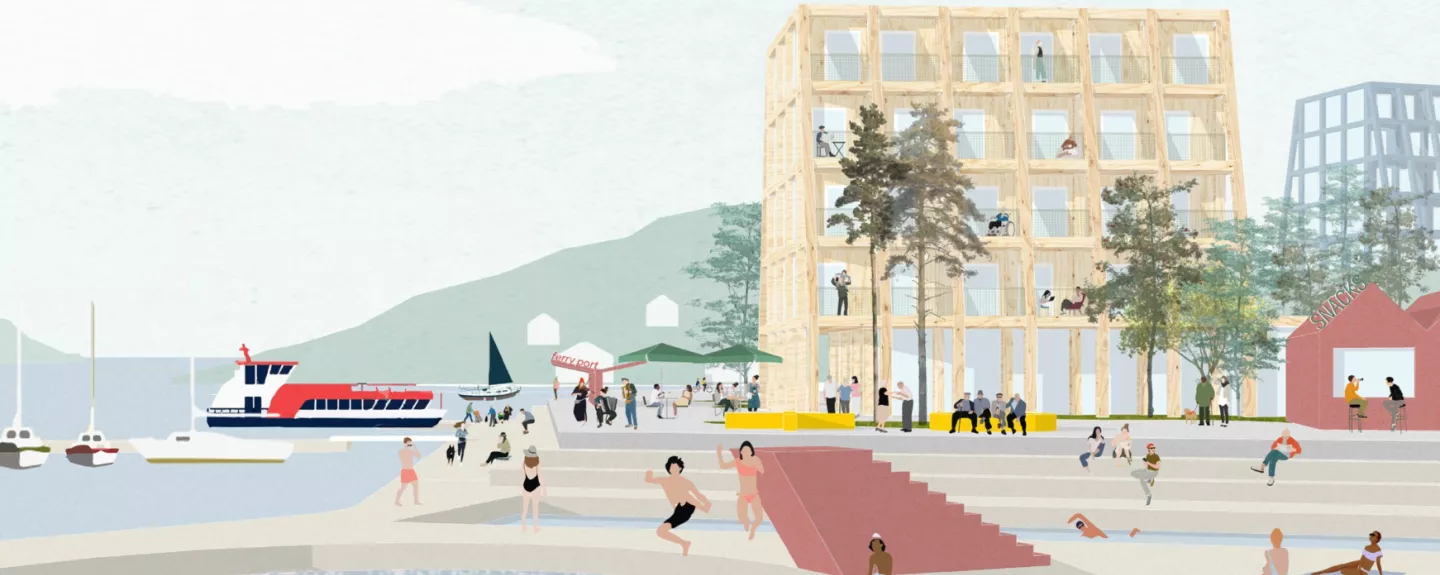
No winner, but two runner-ups in Krøgenes. Co-Krøgens and Krøgenes peninsula shares the prize.
General Remarks by the jury
Krøgenes represents a generic urban development challenge that we encounter all over Europe – how to recreate and reconnect a commercial and production area into a livable mixed-use community. The task was to imagine and plan a new city structure including the issues of how to connect to the rest of the town. More housing is needed in Arendal but can it be created inside the existing structure in phases?
Krøgenes is located apart from the main town structure and is fairly disconnected by public transport. Its development is very dependent on private landowners and their involvement in recreating their properties. Bringing social and environmental sustainability into the urban structure proved to be a demanding task. The strongest proposals managed to imagine a process through which the change may happen in phases. Getting the landowners involved in the change process is a key to make the urban change happen and to do it in a controlled yet successful way.
Most of the proposals kept the existing streets in their places and the urban tissue was almost neglecting the streets, using them only as an outside traffic system, when a few of the proposals showed the potential in modifying the existing traffic system and thus creating a new hierarchy that better fits the suggested urban structure. Both of which could become an interesting and well functioning system if parking, cycling and pedestrian needs were taken carefully into account.
The topology of Krøgenes was better understood in some of the proposals. The height differences are remarkable and the scale of the competition area set a challenge to the competitors. The cluster-type proposals were more interesting theoretically when as many competitors had studied the topologies and ended up in a more organic urban structure that fits the site. The latter seems more feasible also regarding the divided land ownership. Some of the proposals managed to create a sense of one Krøgenes but surprisingly many had decided to keep the different parts of Krøgenes relatively disconnected from one another. This is a general challenge in the development of such mixed use areas whereby neighboring plots may not be constructed simultaneously. One key to success in the further planning and execution of Krøgenes will be how to keep the area as one in spite of the unsynchronized development of individual plots. Keeping and creating pleasant connections and green areas will help the inhabitants get rooted and enjoy their own living area. Many proposals view that the commercial and production functions may stay in the area with careful traffic design.
The jury did not pick a winner, but opted for awarding two runner-ups. The two proposals feature radically different approaches to how they treat the lower area of parking lots and shopping. Co-Krøgenes demonstrates a thorough and convincing attitude towards keeping most of the buildings, and adding new mixes of commercial, offices and housing in the central parts of the site: Turning the large parking lots into an urban structure without killing the activity that is there in the process seems feasible, but it fails at taking the larger site into consideration Also the schemes for the south hill overlooking the harbor are topologically unconvincing.
Krøgenes Peninsula on the other hand, took the task of making a regenerative and climate adapted urban environment seriously and suggested reopening the former marsh. - A move that might be controversial, but answers the call to make more space for other species inside the site as well as increasing the climate resiliency of the new development. While the housing project it proposes next to this new lake has failed to convince the jury or the site representatives, the quality of the seaside developments make up for it.
Both proposals have their shortcomings, which is only to be expected of such a complex site, however together they feature complimentary attitudes and solutions that together will give the municipality and developers the right tools to continue the process. The jury sees important strategic and tactical values in further collaboration with both runners-up.
Download the full report
Team
Marc Rieser (DE)
Jury remarks
Co-Krøgenes receives a shared position as a runner-up due to its excellence as a realistic and sustainable strategy for transforming the big box typologies in Krøgenes. The project succeeds in showing a strategy for maintaining and repurposing a maximum number of existing retail buildings, preserving them as they are, and developing a vibrant mixed-use and car-free urban environment around them. Co-Krøgenes takes the parking issues seriously and demonstrates how the commercial life of the area can be sustained during the transition from car-based big box shopping into a credible mixed-use cluster centered around a successful 10-minute city concept. Furthermore, Co-Krøgenes has integrated a well-developed intermodal structure into the site. This enables Krøgenes to become a well-connected district center with a walkable interior and robust public transport connections while allowing its retail businesses to serve the car-based suburban neighborhoods around it. There is a challenge of spatial quality in the juxtaposition of housing and existing big scale buildings. They often collide with steep topographic differences, which adds to the level of difficulty in further development.
The project is primarily a strategy for the transition of the core areas of Krøgenes rather than a comprehensive design or holistic plan for the entire site. The east side of the site has not been considered, and the plans for new developments on the south hill overlooking the harbor lack realism and architectural qualities.
While the project is not ready for independent implementation, it receives the shared runner-up position because it excels in addressing the most challenging aspects on this site: establishing a strong and sustainable strategy for transforming the big box typology, building on existing elements and avoiding the use of new megastructures to tackle topographical and parking challenges.
Team:
Maria Crammond (US), architect urbanist
Nanna Marie Vindeløv-Rasmussen (DK), landscape architect
Jury remarks:
Krøgenes Peninsula shares the runner-up position for presenting a comprehensive plan which does not just propose a more feasible step by step process, well developed architecture and more detailed social infrastructure than any other proposal, but also takes the call for regenerative and climate resilient solutions seriously.
One of the key features of Krøgenes Peninsula’s vision is re-establishing the old lake. This redefines Krøgenes as a peninsula, which lays a striking new basis for the urban structure. The project proposes eight strategic tools from a blue-green perspective, taking nature, buildings, the community, and mobility into account. Krøgenes Peninsula is communicated in a clear and understandable way both in drawings, text and overall layout.
The existing parking lot is replaced by a lake, a both practical and conceptual move that transforms the entry point and situation of Krøgenes radically into a better place. The project proposes three independent neighborhoods. They are interconnected with green areas as a natural response to the existing topography and the road system. The built up green adds to the natural green landscape.
The proposed housing exhibits numerous qualities, striking a good balance between the built and the natural landscape. The housing areas along the shoreline are especially remarkable. There are splendid residential projects by the harbor and the eastern shoreline. The lakeside housing looks pleasant and makes a huge visual and functional change as the entrance view to the area. The area that used to be a dull suburban bigbox area has been reinvented as a pleasant neighborhood with green lakeviews.
However, the jury would like to see a bolder move when it comes to mobility. Could the local road be transformed, maybe one-directional? The proposed parking along the main road would potentially generate unnecessary car traffic amidst housing.
The housing to the West faces noise from the road, yet several commercial buildings must be torn down to make space for the housing. The jury is unsure whether this is the right location for housing, and it seems as if the idea of the lake has forced its location. The question arises whether the areas “ LakeMeadow” and “Bedrifts” should change places or be integrated, in order to protect housing from noise and require fewer buildings to be demolished. The jury also notes that the lakeside housing may be affected by the existing roads dominating the views.
Regardless of certain weaknesses, the jury values this proposal highly for both its chosen strategies and the topics it has resolved successfully. The jury encourages the team to explore those more with the stakeholders in order to develop an improved holistic and strategic future plan for Krøgenes.
Team:
Rune Nistad (NO), architect
Markus Domaas Lindahl (NO), architect
Irene Camilla Heiaas (NO), historian
Jury Remarks:
The project “Sea you in Krøgenes” provides a clear support for a process-oriented urban redevelopment of the Krøgenes area, which manages to integrate well both the existing buildings and an amount of new urban blocks. It concentrates motorized mobility into the current main roads and generates three urban enclaves with some specific characteristics, over which a connecting network for pedestrians and bicycles is superimposed.
The jury acknowledges the project’s maturity and the clear strategy of dividing the area in ‘motorized exteriors’ and ‘lively interiors’, as well as its understanding of urban structure as a support for diversity. Also, the use of soft mobility as the main connecting ingredient shows a big potential, and helps to solve the otherwise difficult connection between the port and the commercial area.
Less convincing is the project’s typological approach to blocks and urban spaces–. The proposal seems to rely uncritically on present peri-urban standards. The generic characterization of housing and public space types results in an urban landscape that tends to erase the differences, and the proposed layer of anecdotic programming is not able to compensate the lack of urban intensity.
While the large ramps used for bridging the level differences of the site is an interesting idea that could solve both parking and the disconnected nature of the site, it also seems like a massive and complicated solution to a problem that could be solved in simpler ways and create series of issues that the project does not address.
From the jury's point of view, while "Sea you in Krøgenes" certainly offers a credible and mature urban structure, it fails to offer a strong enough narrative to support the construction of the new identity that the current non-place of Krøgenes is demanding.
